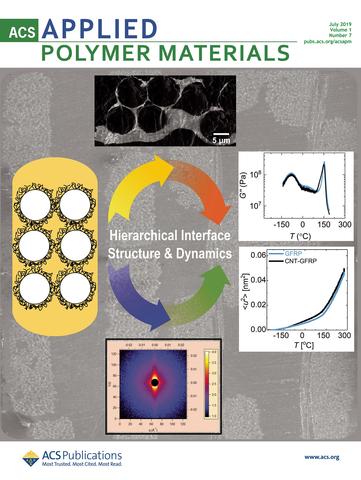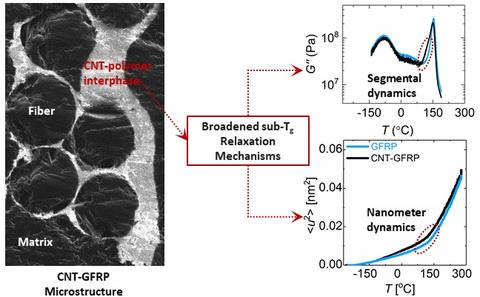Multiscale Polymer Dynamics in Hierarchical Carbon Nanotube Grafted Glass Fiber Reinforced Composites

The multiscale structure-interphase-property relationships observed for FRP hierarchical composites were measured using techniques sensitive to electronic structure, neutron scattering, viscoelastic relaxations, and polymer dynamics.

Given the large area of the of the interface generated through this processing method, the potential for polymer relaxation to affect long term mechanical properties should be evaluated. For example, changes in the conductivity of the CNT network may from polymer matrix relaxation. The measurement challenge is now to quantify the effect of these complex nanofiller-polymer-fiber interfaces on the time-dependent properties of the composite. Here we apply a suite of microscale and nanoscale characterization methods to probe the structure, viscoelastic properties, and nanoscale polymer dynamics in these complex architectures. In particular, we find that the functionalized CNT interface creates a percolated network around the fibers that results in subtle changes to the polymer dynamics. This interface exhibits a higher polymer mobility compared to the composite without nanofillers. These changes are evident at the length scale of the fibers (~ 10 m) down to the nanoscale of the polymer and functionalized CNTs. In the broader context of engineering applications, transport of small molecules (such as water, solvent, etc.), creep and stress relaxation, electrical conductivity and thermal expansion are inherently affected by the structural and viscoelastic variations studied in this paper.
Ajay Krishnamurthy, Ran Tao, Erkan Senses, Sagar M. Doshi, Faraz Ahmed Burni, Bharath Natarajan, Donald Hunston, Erik T. Thostenson, Antonio Faraone, Amanda L. Forster, and Aaron M. Forster “Multiscale Polymer Dynamics in Hierarchical Carbon Nanotube Grafted Glass Fiber Reinforced Composites” ACS Applied Polymer Materials 2019, 1, 1905-1917

